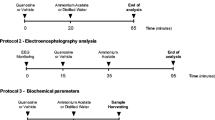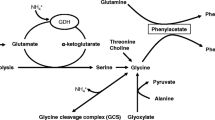Abstract
Since glufosinate irreversibly inhibits glutamine synthetase, leading to intracellular accumulation of ammonia, hyperammonemia is considered one of the main mechanisms of glufosinate ammonium toxicity in humans. However, whether hyperammonemia causes neurotoxicity has not yet been studied. Therefore, the purpose of this study was to determine whether the serum ammonia level is elevated before the development of neurotoxicity. In this retrospective observational study, we analyzed data from consecutive patients diagnosed with acute glufosinate ammonium poisoning. The primary outcome was the development of neurotoxicity following the poisoning. Patients who developed neurotoxicity were characterized by higher initial ammonia levels compared to patients without neurotoxicity (121.0 µg/dL [87.0; 141.0] vs 83.0 µg/dL [65.0; 119.0], p < 0.01). However, there was no increase in ammonia levels over time in both the asymptomatic and neurotoxicity groups when serial serum ammonia levels were examined from emergency department admission to hospital discharge. In addition, there was no statistically significant difference between the peak ammonia levels in the asymptomatic group and the peak ammonia levels before symptom onset in the neurotoxicity group (135.0 µg/dL [109.0; 158.0] vs 144.0 µg/dL [120.0; 189.0], p = 0.15). Following the onset of neurotoxicity, the serum ammonia level increased significantly (125.0 [111.0; 151.0] µg/dL to 148.0 [118.0; 183.0] µg/dL, p < 0.01). In conclusion, hyperammonemia cannot be assumed as the cause of neurotoxicity in glufosinate ammonium poisoning and further research is needed to examine the exact mechanism of GA poisoning.



Similar content being viewed by others
Data availability
Not applicable.
References
Butterworth RF (2002) Pathophysiology of hepatic encephalopathy: a new look at ammonia. Metab Brain Dis 17:221–227
Cha YS, Kim H, Lee Y, Choi EH, Kim HI, Kim OH, Cha KC, Lee KH, Hwang SO (2018) The relationship between serum ammonia level and neurologic complications in patients with acute glufosinate ammonium poisoning: a prospective observational study. Hum Exp Toxicol 37:571–579
Cooper AJ, Plum F (1987) Biochemistry and physiology of brain ammonia. Physiol Rev 67:440–519
Hack R, Ebert E, Ehling G, Leist KH (1994) Glufosinate ammonium—some aspects of its mode of action in mammals. Food Chem Toxicol 32:461–470
Hazell AS, Butterworth RF (1999) Hepatic encephalopathy: an update of pathophysiologic mechanisms. Proc Soc Exp Biol Med 222:99–112
Hirose Y, Kobayashi M, Koyama K, Kohda Y, Tanaka T, Honda H, Hori Y, Yoshida K, Kikuchi M (1999) A toxicokinetic analysis in a patient with acute glufosinate poisoning. Hum Exp Toxicol 18:305–308
Hori Y, Tanaka T, Fujisawa M, Shimada K (2003) Toxicokinetics of DL-glufosinate enantiomer in human BASTA poisoning. Biol Pharm Bull 26:540–543
Kutlesa NJ, Caveney S (2001) Insecticidal activity of glufosinate through glutamine depletion in a caterpillar. Pest Manag Sci 57:25–32
Lee DK, Youk H, Kim H, Kim OH, Go J, Kim TH, Cha K, Lee KH, Hwang SO, Cha YS (2016) Initial serum ammonia as a predictor of neurologic complications in patients with acute glufosinate poisoning. Yonsei Med J 57:254–259
Mao YC, Hung DZ, Wu ML, Tsai WJ, Wang LM, Ger J, Deng JF, Yang CC (2012) Acute human glufosinate-containing herbicide poisoning. Clin Toxicol (phila) 50:396–402
Mao YC, Wang JD, Hung DZ, Deng JF, Yang CC (2011) Hyperammonemia following glufosinate-containing herbicide poisoning: a potential marker of severe neurotoxicity. Clin Toxicol (phila) 49:48–52
Moon JM, Chun BJ (2016) Serial ammonia measurement in patients poisoned with glufosinate ammonium herbicide. Hum Exp Toxicol 35:554–561
Ohtake T, Yasuda H, Takahashi H, Goto T, Suzuki K, Yonemura K, Hishida A (2001) Decreased plasma and cerebrospinal fluid glutamine concentrations in a patient with bialaphos poisoning. Hum Exp Toxicol 20:429–434
Sears ES, McCandless DW, Chandler MD (1985) Disruption of the blood-brain barrier in hyperammonemic coma and the pharmacologic effects of dexamethasone and difluoromethyl ornithine. J Neurosci Res 14:255–261
Skowronska M, Albrecht J (2012) Alterations of blood brain barrier function in hyperammonemia: an overview. Neurotox Res 21:236–244
Takano HK, Dayan FE (2020) Glufosinate-ammonium: a review of the current state of knowledge. Pest Manag Sci 76:3911–3925
Watanabe T, Sano T (1998) Neurological effects of glufosinate poisoning with a brief review. Hum Exp Toxicol 17:35–39
Yeon S, Kim SH, Sim J, Kim S, Lee Y, Kim H, Cha YS (2021) Major component causing neurological toxicity in acute glufosinate ammonium poisoning: determination of glufosinate, 1-methoxy-2-propanol, and ammonia in serum and cerebrospinal fluid, Clin Toxicol (Phila): 1–7
Author information
Authors and Affiliations
Contributions
All of the byline authors meet the ICMJE criteria for authorship. We well understand privilege and responsibility of the authorship of the scientific publications.
We confirm that the manuscript has been read and approved by all named authors and that there are no other persons who satisfied the criteria for authorship but are not listed. We further confirm that the order of authors listed in the manuscript has been approved by all of us. We understand that the Corresponding Author is the sole contact for the Editorial process. He/she is responsible for communicating with the other authors about progress, submissions of revisions, and final approval of proofs.
All authors have made substantial contributions to the following areas:
Conceptualization: Yong Soo Cho.
Data curation: Joochan Kim.
Formal analysis: Seok jin Ryu.
Funding acquisition: None.
Investigation: Byung Kook Lee.
Methodology: Byung Kook Lee.
Software: Dong Hun Lee.
Supervision: Byeong Jo Chun.
Validation: Jeong Mi Moon.
Visualization: Dong ki Kim.
Writing—original draft: Joochan Kim.
Writing—review and editing: Yong Soo Cho.
Approval of final manuscript: all authors.
Corresponding author
Ethics declarations
Ethics approval and consent to participate
We declare that we are keeping global and/or local guidelines of research and publication ethics strictly including authorship. This study was performed in line with the principles of the Declaration of Helsinki. Approval was granted by the Institutional Review Board at Chonnam National University Hospital, Gwangju, South Korea. We the undersigned declare that this manuscript is original, has not been published before, and is not currently being considered for publication elsewhere.
Consent for publication
Not applicable.
Competing interests
The authors declare no competing interests.
Additional information
Publisher's note
Springer Nature remains neutral with regard to jurisdictional claims in published maps and institutional affiliations.
Rights and permissions
Springer Nature or its licensor (e.g. a society or other partner) holds exclusive rights to this article under a publishing agreement with the author(s) or other rightsholder(s); author self-archiving of the accepted manuscript version of this article is solely governed by the terms of such publishing agreement and applicable law.
About this article
Cite this article
Kim, J., Cho, Y.S., Chun, B.J. et al. The trend of ammonia levels in patients with glufosinate ammonium poisoning with respect to neurotoxicity. Naunyn-Schmiedeberg's Arch Pharmacol 396, 525–531 (2023). https://doi.org/10.1007/s00210-022-02327-y
Received:
Accepted:
Published:
Issue Date:
DOI: https://doi.org/10.1007/s00210-022-02327-y




